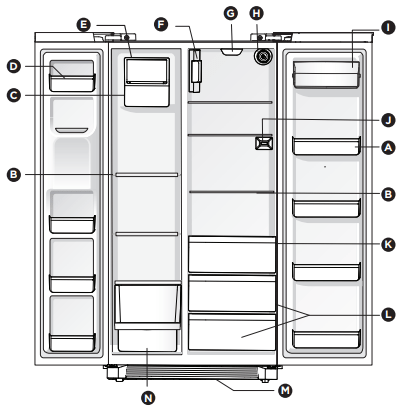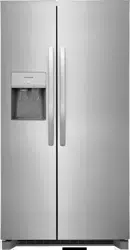Documents: Go to download!
User Manual
- User Manual - (English)
- Use & Care Manual - (Spanish)
- Use & Care Manual - (French)
- Installation Intructions - (English)
- Leveling Cabinet and Doors - (English)
- Product spec sheet - (English)
- Spec Sheet (web) - (English)
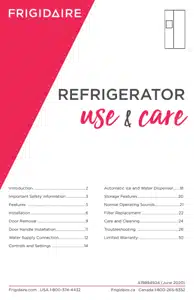
- FEATURES
- INSTALLATION
- DOOR REMOVAL
- DOOR HANDLE INSTALLATION
- WATER SUPPLY CONNECTION
- CONTROLS AND SETTINGS
- AUTOMATIC ICE AND WATER DISPENSER
- STORAGE FEATURES
- NORMAL OPERATING SOUNDS
- FILTER REPLACEMENT
- CARE AND CLEANING
- TROUBLESHOOTING
Table of contents
User manual Refrigerator
FEATURES
A Adjustable Door Bins
B Shelves
C Ice Container
D Fixed Door Bins
E Ice Maker
F Damper/Air filter housing
See other models: FRA123CT1M PHS37EHSW FRT15B1BB LGHS2667KW FPHT1897TR
G Refrigerator LED Light Cover
H Water Filter
I Dairy Compartment
J Temperature Sensor/Thermistor
K Deli Drawer (some models)
L Crisper Pan
M Toe Grille
N Slide Out Basket
INSTALLATION
Location
- Choose a place that is near a grounded electrical outlet. Do Not use an extension cord or an adapter plug.
- If possible, place the unit out of direct sunlight and away from the range, dishwasher or other heat sources.
- Install the appliance on a floor that is level and strong enough to support a fully loaded unit.
- Consider water supply availability for models equipped with an automatic ice maker. If you do not hook up water to the appliance, remember to turn the ice maker off.
Toe Grille Installation and Removal
To install toe grille
- Open both doors. Slide the left and right sides of the toe grille over the lower hinges of the appliance.
- While pushing the toe grille firmly against cabinet, fasten the bottom clips of toe grille to the cabinet.
- Fasten the top clips to the cabinet.
- Close the doors. Fasten the right and left side clips into the groove of the bottom hinge.

To remove the toe grille
- With both doors closed, unfasten the right and left side clips of toe grille from the bottom hinge groove.
- Open both doors. Press firmly on the top of the toe grille until the top of the toe grille pops off.
- Pull the toe grille outward toward your body and off of the lower hinges.

Door Opening
Position your unit to allow easy access to a counter or table when removing food. For the best use of drawers and freezer baskets, position the appliance where both doors can fully open.
Guidelines for final positioning of your unit:
- Rest all 4 corners of the cabinet firmly on the floor.
- Level the cabinet at the front and rear.
- Tilt the sides ¼" (6 mm) from front to back (to ensure the doors close and seal properly).
- Align the doors with each other and level.
Meet all of these conditions by raising or lowering the adjustable front rollers.
To level the cabinet using the front rollers:
1. Open both doors and remove the toe grille (see “Toe Grille Installation and Removal” in the INSTALLATION section).
2. Close the doors and use a wrench to raise (clockwise) or lower (counterclockwise) the front rollers.
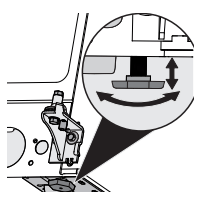
3. Ensure both doors are bind-free with their seals touching the cabinet on all 4 sides.
To level the doors using the adjustable lower hinge:
1. Before leveling either door, remove the set screw that locks the door height into position. (The door cannot be adjusted without the set screw removed).
2. If the refrigerator door is lower than the freezer door, raise the refrigerator door by turning the adjustment screw counterclockwise using a 7 /16" wrench. (See illustration.)
3. If the freezer door is lower than the refrigerator door, raise the freezer door by turning the adjustment screw counterclockwise using a 7 /16" wrench. (See illustration.)

4. After leveling, verify the door stop contacts the lower hinge and the top of the door does not contact the upper hinge through full movement of the door (from fully closed to fully open).

5. Reinstall the set screw, locking the door height.
6. Replace the toe grille by fitting it into place (see “Toe Grille Installation and Removal” in the INSTALLATION section).
DOOR REMOVAL
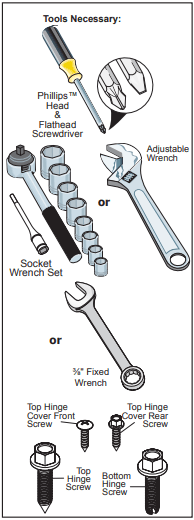
To remove the refrigerator top hinge/cover:
1. Remove the 2 screws from the cover over the top door hinge.
2. Lift hinge cover straight up and off.
3. Trace lightly around the door’s top hinge with a pencil. This makes reinstallation easier.
4. Remove the 2 screws from the top hinge and lift the hinge straight up. Lift the door off of the bottom hinge and set it aside.
5. Remove the 2 bottom hinge screws and hinge if necessary

To reinstall the refrigerator door, reverse the above steps.
DOOR HANDLE INSTALLATION
CAUTION Wear gloves and safety goggles and use extreme CAUTION when installing these handles. The rounded end of the handles may be sharp (some models).
IMPORTANT To ensure proper installation of handles, please review these instructions and illustrations thoroughly prior to installing the handles.
- Remove handles from carton and any other protective packaging.
- Position the freezer handle end caps over the upper and lower pre-installed shoulder bolts (A) that are fastened into door, ensuring the holes for the set screws are facing toward the refrigerator door.
- While holding the handle firmly against door, fasten the upper and lower Allen set screws (B) with the supplied Allen wrench.
- Repeat steps 2 and 3 to install refrigerator handle. Ensure the holes for the set screws are facing towards the freezer door.
NOTE Tighten and sub-flush all set screws (place the Allen set screw just below the surface of the end cap) of the handle end cap. Draw the end caps tight to the freezer and refrigerator doors with no gaps. To avoid scratching the metal door, keep the door open while torquing down the set screws.
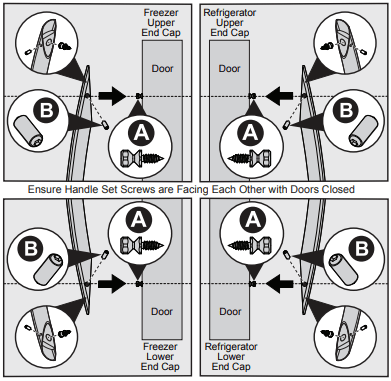
WATER SUPPLY CONNECTION
Before Installing The Water Supply Line, You Will Need:
- Basic Tools: adjustable wrench, flat-blade screwdriver, and PhillipsTM screwdriver
- Access to a household cold water line with water pressure between 30 and 100 psi.
- A water supply line made of ¼" (6.4 mm) OD, copper or stainless steel tubing. To determine the length of tubing needed, measure the distance from the ice maker inlet valve at the back of the refrigerator to your cold water pipe. Then add approximately 7' (2.1 m), so the refrigerator can be moved out for cleaning.
- A shutoff valve to connect the water supply line to your household water system. DO NOT use a self-piercing type shutoff valve.
- Do not reuse compression fitting or use thread seal tape.
- A compression nut and ferrule (sleeve) for connecting a copper water supply line to the ice maker inlet valve.
NOTE Check with your local building authority for recommendations on water lines and associated materials prior to installing your new refrigerator. Depending on your local/state building codes, Frigidaire recommends for homes with existing valves its Smart Choice® water line kit 5304490728 (with a 6' Stainless Steel Water Line) and for homes without an existing valve, Frigidaire recommends its Smart Choice® water line kit 5304490717 (with a 20' copper water line with self-tapping saddle valve). Please refer to Frigidaire.com for more information.
To Connect Water Supply Line To Ice Maker Inlet Valve
1. Disconnect the refrigerator from electrical power source.
2. Place the end of the water supply line into a sink or bucket. Turn ON the water supply and flush the supply line until the water is clear. Turn OFF the water supply at the shutoff valve.
3. Remove the plastic cap from the water valve inlet and discard the cap.
4. If you use copper tubing - Slide the brass compression nut, and then the ferrule (sleeve) onto the water supply line. Push the water supply line into the water valve inlet as far as it will go (¼"/6.4 mm). Slide the ferrule (sleeve) into the valve inlet and finger tighten the compression nut onto the valve. Tighten another half turn with a wrench; DO NOT overtighten. See Figure 1.
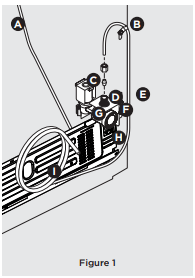
If you use braided flexible stainless steel tubing - The nut is already assembled on the tubing. Slide the nut onto the valve inlet and finger tighten the nut onto valve. Tighten another half turn with a wrench; DO NOT overtighten. See Figure 2.
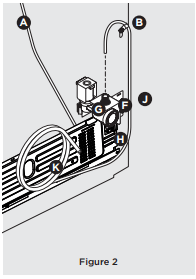
A Plastic Water Tubing to Ice Maker Fill Tube
B Steel Clamp
C Brass Compression Nut
D Ferrule (Sleeve)
E Copper Water Line
F Water Valve Bracket
G Valve Inlet
H Water Valve
I Copper Water Line from
Household Water Supply*
J Braided Flexible Stainless Steel Water Line
K 6 ft. (1.8 m) Braided Flexible Stainless Steel Water Line from
Household Water Supply*
*Include enough tubing in the loop to allow moving the refrigerator out for cleaning
5. With the steel clamp and screw, secure the water supply line (copper tubing only) to the rear panel of refrigerator as shown.
6. Coil the excess water supply line (copper tubing only), about 2½ turns, behind refrigerator as shown and arrange coils so they do not vibrate or wear against any other surface.
7. Turn ON the water supply at shutoff valve and tighten any connections that leak.
8. Reconnect the refrigerator to electrical power source.
IMPORTANT
After connecting the water supply, refer to “Priming the Water Supply System” for important information about priming an empty water supply system.
Your refrigerator’s water supply system includes several tubing lines, a water filter, and a water valve. To ensure that your water dispenser works properly, completely fill this system with water when you first connect your refrigerator to the household water supply line.
CONTROLS AND SETTINGS
NOTE Your appliance may have some or all of the features listed below. Become familiar with these features and their use and care.
Front of Door User Interface
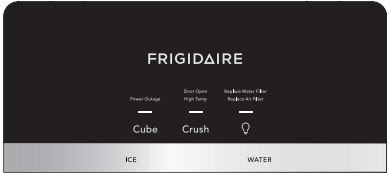
Cube
Press the Cube button to get cubed ice. A white LED light will indicate the mode is selected. Press glass against the ice dispensing paddle as far up as possible to catch all the ice.
Crush
Press the Crush button to get crushed ice. A white LED light will indicate the mode is selected. Press glass against the ice dispensing paddle as far up as possible to catch all the ice.
Light 
Press the light button  to turn on the dispenser light. A white LED light will indicate the dispenser light is on. Press again to turn the light off.
to turn on the dispenser light. A white LED light will indicate the dispenser light is on. Press again to turn the light off.
Water
To operate the water dispenser, press a glass against the Water dispensing paddle. To stop dispensing water, pull the glass away from the dispensing paddle. Dispensed water is not cold. For colder water, add crushed ice or cubes before dispensing water.
Water Filter Status
When you need to order a new water filter, the side door UI will change to the Order status. When you need to replace the water filter, the Side Door UI will change to the red replace status and the front UI will display Replace Water Filter. After you change the filter, hold the Water Filter button for 3 seconds to reset.
Air Filter Status*
When you need to order a new air filter, the Side Door UI will change to the Order status. When you need to replace the air filter, the Side Door UI will change to the red Replace status and the Front UI will display Replace Air Filter. After you change the filter, hold the Air Filter button for 3 seconds to reset.
*Only on some models
Alarms
Power Outage
In the event of a power outage the Power Outage indicator appear and an alarm will sound. Press any button to clear the alarm.
Door Open
When a door is open the Door Open indicator will appear and will disappear when the door is closed. If a door is left open for more than 5 minutes an alarm will sound. The alarm will continue to go off every 10 seconds until acknowledged. Close the door to turn off the alarm or press any button on the control to temporarily disable the alarm.
High Temp
In the event of the internal temperature of the refrigerator rising and staying at a temperature above the safe temp zone for a period of time, the High Temp warning will appear to remind you to check your food. In addition to the indicator, an alarm will sound every 10 seconds until acknowledged. Press any button to clear the warning.
The refrigerator will automatically try to cool down to improve the condition. However, if the temperature has not cooled after some time, the warning and alarm will appear again. If the problem continues please call 1 (800) 372-4432.
In-Door User Interface

In-Door Control Display Mode Views
Your display is equipped with a sleep and inactive mode to prevent accidental changes to the unit settings during opening and closing of the doors. When both doors are closed, the display will be in sleep mode. When either door is first opened, the display will be in inactive mode where all the current settings are visible but dimmed.
Pressing any button on the display will activate the display and a tone will be played. All settings will then be fully lit. Touch the display again to change any setting.
If there is no button pressed for 10 seconds while any door is open, the display will default back to inactive mode.
Temperature Adjustment
Adjust the temperature gradually: adjust in small increments, allowing the temperature to stabilize.
- For colder temperatures, press the Temp button to change the temperature setting toward Coldest.
- For warmer temperatures, press the Temp button to change the temperature setting toward Cold.
Adjusting the refrigerator control will change temperature in both compartments. The freezer control can be left at the factory preset (*Recommended) or adjusted as desired.
To maintain temperatures, a fan circulates air in the refrigerator and freezer compartments. For good circulation, do not block cold air vents with food items.
Air Filter Status*
The display shows the current status of the air filter (Good, Order, or Replace). To reset the filter status to Good, press and hold Air Filter for 3 seconds.
Water Filter Status
The displays shows the current status of the water filter (Good, Order, or Replace). To reset the filter status to Good, press and hold Water Filter for 3 seconds.
*Only on some models
AUTOMATIC ICE AND WATER DISPENSER
Priming the water supply system
- Begin filling the system by pressing and holding a drinking glass against the water dispenser paddle.
- Keep the glass in this position until water comes out of the dispenser. It may take about 1½ minutes. Water will sputter until you purge all air from the water lines.
- Continue dispensing water for about minutes to flush the system and plumbing connections of any impurities (stopping to empty the glass as necessary).
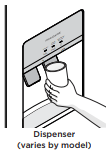
NOTE Dispensed water is not chilled. For colder water, add ice to cup or container before dispensing water.
Ice maker operation & care
After you properly install the refrigerator and it has cooled for several hours, the ice maker can produce ice within 24 hours. The ice maker will fill the ice bin from the rear. You must dispense some ice to force the ice forward in the bin. This will allow the bin to fill completely
Turning the ice maker on
To turn the ice maker on, press the ice maker's On/Off power switch, located on the front of the ice maker, so the LED is steadily illuminated.

IMPORTANT Turning off the ice maker simply disables ice making. You will still be able to dispense existing ice, and you will still be able to dispense water.
NOTE The ice maker also has a built-in plastic signal arm that automatically stops ice production when the ice bin is full. Do not use this signal arm to manually stop the ice maker.
Cleaning the Ice Storage Bin
Clean the ice storage bin at regular intervals, particularly before you take a vacation or move.
To clean the ice storage bin:
- Turn Off the ice maker.
- Remove the ice storage bin by lifting up and out.
- Empty and carefully clean the ice storage bin with mild detergent. Rinse with clear water. Do not use harsh or abrasive cleaners.
- Allow the ice storage bin to dry completely before replacing it in the freezer.
- Remove ice chips and clean the ice storage bin, shelf and the freezer door chute.
- Replace the ice storage bin. Turn On the ice maker to resume ice production.
Remove and empty the ice storage bin if:
- An extended power failure (1 hour or longer) causes ice cubes in the ice storage bin to melt and freeze together, jamming the dispenser mechanism.
- You do not use the ice dispenser frequently. Ice cubes will freeze together in the bin, jamming the dispenser mechanism.
Remove the ice storage bin and shake to loosen the cubes or clean as explained above.
CAUTION NEVER use an ice pick or similar sharp instrument to break up the ice. This could damage the ice storage bin and dispenser mechanism.
IMPORTANT When removing or replacing the ice storage bin, avoid rotating the auger in the ice storage bin. If the auger is accidentally rotated, you must realign the auger by turning it in 45 degree turns (see below) until the ice storage bin fits into place with the drive mechanism If the auger is not properly aligned when replacing the ice storage bin, the refrigerator will not dispense ice. The freezer door also may not close properly causing warm air to leak into the freezer compartment.
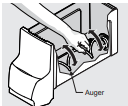
STORAGE FEATURES
Glass shelves
Shelves are easily adjusted to suit individual needs. Before adjusting the shelves, remove all food. Shelves are supported by side rails. See "Glass Shelves" in CARE AND CLEANING for proper shelf removal.
Door storage
Door bins and shelves are provided for convenient storage of jars, bottles, and cans. You can quickly select frequently used items.
Some models have door bins that can accommodate gallon-sized plastic drink containers and economy-sized jars and containers. Some bins are adjustable for maximum storage capacity.
The dairy compartment, which is warmer than the general food storage section, is intended for short term storage of cheese, spreads, or butter.
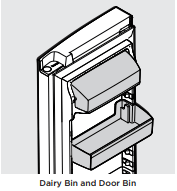
Crispers
Crispers allow you the flexibility to store any manner of items including fruits, vegetables, nuts, etc. Crispers do not feature humidity controls.

Deli Drawer (some models)
Some models are equipped with a Deli Drawer for storing luncheon meats, spreads, cheeses and other deli items. This drawer does not have a separate temperature control.
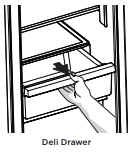
NORMAL OPERATING SOUNDS
Understanding the Sounds you may Hear
Your new, high-efficiency unit may introduce unfamiliar sounds. These sounds normally indicate your appliance is operating correctly. Some surfaces on floors, walls, and kitchen cabinets may make these sounds more noticeable.
Following is a list of major components in your unit and the sounds they can cause:
A Evaporator Refrigerant through the evaporator may create a boiling or gurgling sound.
B Evaporator fan You may hear air being forced through the refrigerator by the evaporator fan.
C Defrost heater During defrost cycles, water dripping onto the defrost heater may cause a hissing or sizzling sound. After defrosting, a popping sound may occur.
D Condenser fan You may hear air being forced through the condenser.
E Compressor Modern, high-efficiency compressors run much faster than in the past. The compressor may have a high-pitched hum or pulsating sound.
F Water valve Makes a buzzing sound each time it opens to fill the ice maker.
G Drain pan (not removable) You may hear water dripping into the drain pan during the defrost cycle.
H Condenser May create minimal sounds from forced air.
I Motorized damper May produce intermittent humming during operation.
J Ice chute When dispensing ice, you will hear a snapping or clicking sound when the solenoid opens and closes the ice chute.
K Ice Maker When ice has been produced, you will hear ice cubes falling into the ice bin.
NOTE Energy efficient foam in your refrigerator is not a sound insulator.
NOTE During automatic defrost cycle, a red glow in the back wall vents of your freezer compartment is normal.
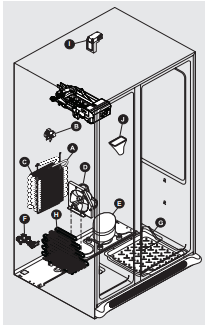
FILTER REPLACEMENT
Replacing the Water Filter
The water filter is located at the top right side of the re- frigerator compart- ment. In general, you should change the water filter every 6 months to ensure the highest possible water quality. Water Filter Status on the user interface prompts you to replace the filter after a standard amount of water (125 gal/453 L for PurePour™)has flowed through the system.
If you have not used your refrigerator for a period of time (during moving for example), change the filter before reinstalling the refrigerator.

To replace your PurePour™ water filter:
It is not necessary to turn the water supply off to change the filter. Be ready to wipe up any small amounts of water released during the filter replacement.
- Turn Off the ice maker.
- Remove the filter by pushing on the end/face of the filter.
- Slide the old water filter cartridge straight out of the housing and discard it.
- Unpackage the new filter cartridge. Using the alignment guide, slide it gently into the filter housing until it stops against the snap-in connector at the back of the housing.
- Push firmly until the cartridge snaps into place (you should hear a click as the cartridge engages the snap-in connector).
- Press a drinking glass against the water dispenser while checking for any leaks at the filter housing. Any spurts and sputters that occur as the system purges air out of the dispenser system are normal.
- After filling one glass of water, continue flushing the system for about 4 minutes.
- Turn On the ice maker.
- Press and hold the Water Filter reset button on the Ice & Water Dispenser control panel for 3 seconds. When the display changes from red to green, the status has been reset.
Air Filter (some models)
Some models are pre-loaded with an air filter located at the top of the fresh food compartment, next to the water filter.
Replacing the Air Filter
You should change your air filter every 6 months (the filter status light on the control panel prompts you to replace the filter after 6 months) to optimize the reduction of refrigerator odors. Different foods will emit various levels of odor. To install your new FRGPAAF1 PureAirTM AF-1 air filter:
- Pull the air filter housing straight out.
- Remove the old filter and discard it (if applicable).
- Unpack the new filter and place it inside the housing.
- Slide the housing back into position.
- Activate or reset the Air Filter status light on the control panel.

Damper/Air Filter Housing
In humid regions certain products stored too close to the damper/air filter housing may freeze. If this scenario occurs, adjust the fresh food temperature settings and reconfigure the top shelf storage to allow for proper air diffusion.
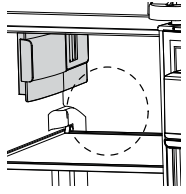
CARE AND CLEANING
Replacing the LED Light Bulb
- Unplug the refrigerator.
- Wearing gloves, slide the clear light cover along the top of the unit toward the front of the unit.
- Replace the old LED bulb with a bulb no greater than 5 watts. Caution: Wear gloves when replacing the LED bulb to avoid getting cut. Use the same wattage when replacing the LED bulb.
- Replace the light cover
- Plug in the refrigerator.
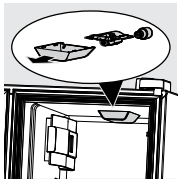
Glass Shelves
Refrigerator: Shelves are easily adjusted to suit individual needs. Before adjusting the shelves, remove all food. Shelves are supported by side rails.
To adjust, lift up on the back of the shelf and pull forward.
Replace the shelf by sliding it on top of the formed rails on the side walls of the cabinet until the rear plastic hooks of the shelf lock into the rear of the cabinet liner.
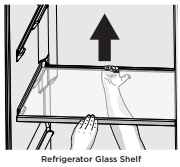
Freezer: You can remove the glass freezer shelf for cleaning. Remove all food from the glass shelf. Rotate the front trim down to remove front trim (Figure 1).
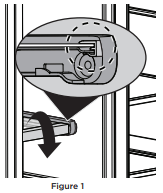
Remove both the rear trim and glass by pulling up on the rear tab and sliding the shelf forward (Figure 2)
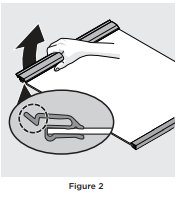
To reassemble the freezer shelf, slide the glass and rear trim along the shelf rails while pressing the shelf downward until it is fully locked into place in the rear (Figure 3).
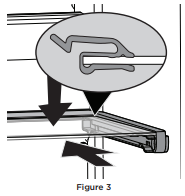
Finally, rotate the front trim upward on the front edge of the glass shelf (Figure 4).
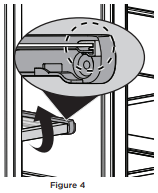
Interior & Door Liners
- Soap and water
- Baking soda and water
Use 2 Tbsp of baking soda in 1 qt of warm water. Be sure to wring excess water out of sponge or cloth before cleaning around controls, light bulb or any electrical part.
Door Gaskets
- Soap and water
Wipe gaskets with a clean soft cloth.
Drawers & Bins
- Soap and water
Use a soft cloth to clean drawer runners and tracks.
Glass Shelves
- Soap and water
- Glass cleaner
- Mild liquid sprays
See "Glass shelves" in CARE AND CLEANING before cleaning. Allow glass to warm to room temperature before immersing in warm water
Toe Grille
- Soap and water
- Mild liquid sprays
- Vacuum attachment
Vacuum dust from front of toe grille. Remove toe grille (see Installation Instructions). Vacuum backside, wipe with sudsy cloth or sponge. Rinse and dry.
Exterior & Handles
- Soap and water
- Non Abrasive Glass Cleaner
Do not use commercial household cleaners containing ammonia, bleach or alcohol to clean handles. Use a soft cloth to clean smooth handles. DO NOT use a dry cloth to clean smooth doors.
Exterior & Handles (Stainless Steel Models Only)
- Soap and water
- Stainless Steel Cleaners
Never use CHLORIDE or cleaners with bleach to clean stainless steel. Clean stainless steel front and handles with non-abrasive soapy water and a dishcloth. Rinse with clean water and a soft cloth. Use a non-abrasive stainless steel cleaner. These cleaners can be purchased at most home improvement or major department stores. Always follow manufacturer’s instructions. Do not use household cleaners containing ammonia or bleach.
NOTE: Always clean, wipe and dry with the grain to prevent scratching. Wash the rest of the cabinet with warm water and mild liquid detergent. Rinse well, and wipe dry with a clean soft cloth.
Replacing LED Bulbs
- Unplug refrigerator
- Wear gloves
- Replace the Refrigerator light cover by sliding the cover forward along the top
- Replace old LED bulb
- Replace light cover
- Plug in the refrigerator
CAUTION: Wear gloves when replacing LED bulbs to avoid getting cut. Use only a 5-watt or less AC LED light bulb.
TROUBLESHOOTING
AUTOMATIC ICE MAKER
Ice maker is not making any ice.
- Ice maker is not on.
- Saddle valve on cold water pipe is clogged or restricted by foreign material.
Ensure the ice maker is on (green light).
The ice and water filter cartridge may be clogged. Replace filter cartridge.
Turn off household water line valve. Remove valve. Ensure that valve is not a self-piercing saddle valve. Clean valve. Replace valve if necessary.
Ice maker is not making enough ice.
- Check to see if water dispenser is dispensing slower than normal.
If it is, replace the ice and water filter cartridge.
- Freezer control is set too warm.
Set freezer control to colder setting to improve performance of the ice maker. Allow 24 hours for temperature to stabilize.
Ice maker will not stop making ice.
- Ice maker arm is being held down by some item in the freezer.
Move item and release arm. Remove any ice cubes that are frozen together over the arm.
Ice cubes are freezing together.
- Ice cubes are not being used frequently enough.
Remove ice container and discard ice from container. Ice maker will produce fresh supply.
- Ice cubes are hollow (partially frozen cubes with water inside).
The ice and water filter cartridge may be clogged. Replace filter cartridge.
- Freezer control is set too warm.
Set freezer control to colder setting. Allow 24 hours for temperature to stabilize.
DISPENSER (Ice & Water)
Dispenser will not dispense ice.
- There is no ice in the bin to be dispensed.
See the “Ice maker is not making any ice” section above.
- The refrigerator doors are not completely closed.
Be sure to close the refrigerator completely.
- Dispenser paddle has been pressed too long and the dispenser motor has overheated.
The motor overload protector will reset in about 3 minutes and then ice can be dispensed.
- Not dispensing ice regularly may melt and refreeze ice causing ice clumping. Dispensing clumps could damage the ice bucket.
Empty the ice bucket monthly or regularly dispense ice. For longer periods of time (vacation or vacant homes) see Ice Maker/Dispenser Tips in the AUTOMATIC ICE AND WATER DISPENSER section to turn off the ice maker.
Ice dispenser is jammed.
- Ice has melted and frozen around auger due to infrequent use, temperature fluctuations, and/or power outages.
Remove ice container, thaw, and empty the contents. Clean container, wipe dry, and replace in proper position. When new ice is made, dispenser should operate. See Cleaning the Ice Storage Bin in the AUTOMATIC ICE AND WATER DISPENSER section.
- Ice cubes are jammed between ice maker and back of ice container.
Remove ice cubes that are jamming the dispenser.
Dispenser will not dispense water.
- Water filter not seated properly.
Remove and reinstall the water filter. Be sure to push the filter firmly so that you hear it lock solidly into position.
- Water filter is clogged.
Replace filter cartridge. Be sure to remove protective caps and push the filter firmly so that you hear it lock solidly into position.
- Household water line valve is not open.
Open the household water line valve.
Water has an odd taste and/ or odor.
- Water has not been dispensed for an extended period of time.
Draw and discard 10-12 glasses of water to freshen the supply.
- Unit not properly connected to cold water line.
Connect unit to cold water line that supplies water to the kitchen faucet.
Water pressure is extremely low.
- Cut-off and cut-on pressures are too low (well systems only).
Have someone turn up the cut-off and cut-on pressure on the water pump system (well systems only).
- Reverse osmosis system is in regenerative phase.
It is normal for a reverse osmosis system to be below 20 psi during the regenerative phase.
See the WATER SUPPLY CONNECTION section.
Water not cold enough.
- As warmer tap water goes through the filter and enters the water tank the chilled water is pushed through to the dispenser. Once the chilled water is used up it will take several hours to bring the freshly replaced water to a cooler temperature
Add ice to cup or container before dispensing water.
- Some models are designed without a water tank, these water dispensing systems are not designed to chill water.
Add ice to cup or container before dispensing water.
OPENING/CLOSING OF DOORS/DRAWERS
Door(s) will not close.
- Door was closed too hard, causing other door to open slightly.
Close both doors gently.
- Refrigerator is not level. It rocks on the floor when moved slightly.
Ensure floor is level and solid, and can adequately support the refrigerator. Contact a carpenter to correct a sagging or sloping floor.
- Refrigerator is touching a wall or cabinet.
Ensure floor is level and solid, and can adequately support the refrigerator. Contact a carpenter to correct a sagging or sloping floor.
Drawers are difficult to move.
- Food is touching shelf on top of drawer.
Remove top layer of items in drawer.
- Track that drawers slide on is dirty.
Ensure drawer is properly installed on track.
Clean drawer, rollers, and track. See CARE AND CLEANING.
RUNNING OF REFRIGERATOR
Compressor does not run.
- Freezer control is set to “OF” or “0”.
Set freezer control.
- Refrigerator is in defrost cycle.
This is normal for a fully automatic defrost refrigerator. The defrost cycle occurs periodically, lasting about 30 minutes.
- Plug at electrical outlet is disconnected.
Ensure plug is tightly pushed into outlet
- House fuse blown or tripped circuit breaker.
Check/replace fuse with a 15 amp time-delay fuse. Reset circuit breaker.
- Power outage.
Check house lights. Call local electric company.
Refrigerator runs too much or too long.
- Room or outside weather is hot.
It’s normal for the refrigerator to work longer under these conditions.
- Doors are opened too frequently or too long.
Warm air entering the refrigerator causes it to run more. Open doors less often.
- Refrigerator/freezer door may be slightly open.
Ensure refrigerator is level. Keep food and contains from blocking door. See CONCERN column OPENING/CLOSING OF DOORS/DRAWERS.Ensure refrigerator is level. Keep food and contains from blocking door. See CONCERN column OPENING/CLOSING OF DOORS/DRAWERS.
- Freezer control is set too cold.
Set Refrigerator control to warmer setting until refrigerator temperature is satisfactory. Allow 24 hours for temperature to stabilize.
- Refrigerator/freezer gasket is dirty, worn, cracked, or poorly fitted.
Clean or change gasket. Leaks in door seal will cause refrigerator to run longer in order to maintain desired temperatures.
- Condenser is dirty
Clean condenser. See CARE AND CLEANING.
Compressor goes off and on frequently.
- Thermostat keeps the refrigerator at a constant temperature.
This is normal. Refrigerator goes on and off to keep temperature constant.
Appliance seems to run continuously
- The appliance is equipped with an energy-efficient variable speed compressor. It actually saves energy running more frequently.
This is normal.
DIGITAL TEMPERATURE DISPLAY
Digital temperature displays are flashing.
- Electronic control system has detected a performance problem.
Call your Frigidaire service representative, who can interpret any messages or number codes flashing on the digital displays.
WATER/MOISTURE/FROST INSIDE REFRIGERATOR
Moisture collects on inside of refrigerator walls.
- Weather is hot and humid.
The rate of frost buildup and internal sweating increases.
- Door is slightly open.
See CONCERN column OPENING/ CLOSING OF DOORS/DRAWERS.
Water collects on bottom side of drawer cover.
- Vegetables contain and give off moisture.
It is not unusual to have moisture on the bottom side of the cover.
Move humidity control (some models) to lower setting.
Water collects in bottom of drawer.
- Washed vegetables and fruit drain while in the drawer.
Dry items before putting them in the drawer. Water collecting in bottom of drawer is normal.
Stored products on top shelf freeze
- Fresh food temperature setting too cold.
Adjust fresh food temperature settings.
- Certain products stored too close to damper / air filter housing.
Reconfigure top shelf storage to allow proper diffusion of air. See Damper/Air Filter Housing in the FILTER REPLACEMENT section.
WATER/MOISTURE/FROST OUTSIDE REFRIGERATOR
Moisture collects on outside of refrigerator or between doors.
- Weather is humid.
This is normal in humid weather. When humidity is lower, the moisture should disappear.
- Door is slightly open, causing cold air from inside refrigerator to meet warm air from outside.
See CONCERN column OPENING/ CLOSING OF DOORS/DRAWERS.
